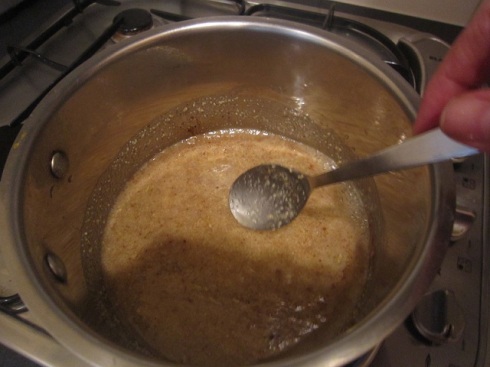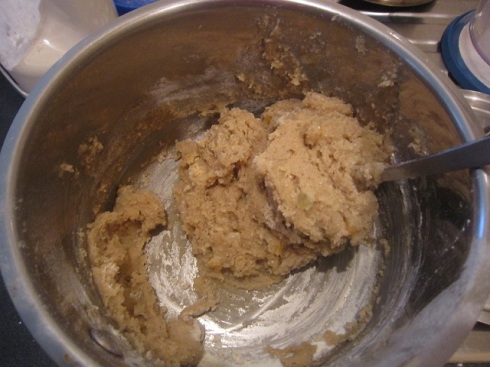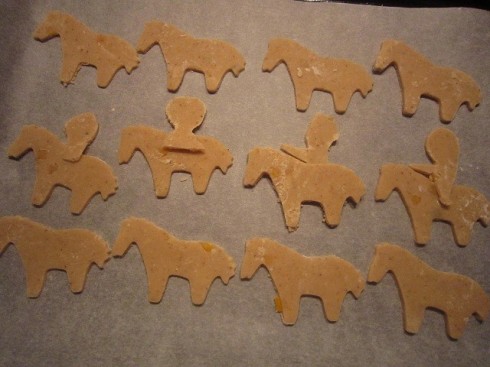You may be wondering what’s become of Lamingtons & Lasagna lately, and why she hasn’t managed to blog in nearly five months. Or, more likely, you hadn’t noticed. In any case, I’ve been a busy PhD bee – I went to Italy to present a paper at an Italian food conference in Perugia (yes, really, I know, I can’t believe it either) and then came home to present another paper at the Australian Historical Association conference in Adelaide. Both papers were accepted for publication so I’ve been spending a lot of time in my pyjamas, in my study, writing like a crazy woman…
And yesterday, I finished!
Hooray! To celebrate I thought I’d get out of my pyjamas and cook a retro recipe, like I used to in the blog days of old.
Today’s retro recipe is very special indeed. It was also a disaster, but we’ll get to that shortly.
It comes from the First Australian Continental Cookery Book (FACCB), the subject of my second paper, which is, in my scholarly opinion, Australia’s first Italian cookbook. Btw if you followed the appeal to find the Italian version of the book, I found it thanks to the fabulous Blake Singley at ANU who pointed out that the Italian version was hiding behind the English version at the NLA all along…
But I digress. The recipe is from 1937 and is called Siennese “Little Horses”, or, in the Italian version of the same book Cavallucci di Siena. It’s a classic kind of Italian recipe – meaning there’s a version of it in Pellegrino Artusi’s Science in the Kitchen and the Art of Eating Well – but this version was meant for Australians of the 1930s to cook. Which is perhaps why it suggests the biscuits be cut into the shape of horses with jockeys atop, despite Artusi pointing out that they should be oval-shaped, not horse-shaped. There’s a sense of whimsy and fun in the FACCB, something not present in most other cookbooks of its day, who would never say, for example, of a lamb dish, “to start with, it must be real lamb, not mutton rejuvenated like ambitious ladies on the wrong side of forty”.
But I digress (again!) What does one need for this recipe? Sugar, walnuts, candied orange peel, fennel seeds, mixed spice, nutmeg, flour and a “mould” of a horse with a jockey on top. Not surprisingly, I didn’t have the latter so I hot-footed it over to the local kitchenware shop and asked the lady for a biscuit cutter in the shape of a horse with a jockey. Unfortunately, this came out as “do you have any “horsey” biscuit cutters with jockeys”. To which she should’ve replied, how old are you? Three? But instead said, yes, we do, but there’s no jockey. Quickly deciding I had the necessary skills to fashion a jockey from dough, though, in hindsight, no hard evidence to support this decision, I parted with $2.50 and took my horsey cookie cutter home.
Now in the kitchen, I was all set to start. First, I read the recipe through because in 36 years of life I have figured out that this is always a good idea. A red flag appeared. The recipe only wanted enough flour to cover a board. Hmmm, I would think you’d need more flour for a biscuit dough? I thought about it for all of a minute and then decided that the walnuts which were to be “finely minced” would replace the flour, like almond meal. So all good. Then I was flummoxed by this sentence “Dissolve in a casserole about one pound of sugar in about a third of its weight in water.” A pound is almost half a kilo, right? So a third of almost half a kilo? My head hurts when a little thing like maths rears its very ugly stupid head, so I decided to change all the measurements – I’ll use a cup of sugar, and therefore will need a third of a cup of water, and I’ll scale all the measurements accordingly. Maths will not defeat me, I am smart, I am a PhD student, I can do this. This red flag was so big it was like the ones matadors use for bulls. But I ignored it like the beautiful idiot that I am.
Next challenge was the “mincing” of the walnuts. Now, I don’t know how they minced walnuts in 1937, but here’s how I did it:
And then I was off. In goes the sugar and the water, to which “as soon as it begins to liquefy” I added the minced walnuts, the candied peel, the mixed spice and the fennel seeds:
And out came a watery brown mess. It resembled something which belongs in the bathroom, not the kitchen. But the recipe told me to: “mix well and spread on a board well covered with flour.”
I mixed and mixed and mixed. Nothing changed. I couldn’t see how I could possibly pour this latte-like hot sugar syrup on a board, no matter how well it was floured. Something had gone drastically wrong. Either I had screwed up the measurements or the recipe was a bit wrong, or both. In any case, I needed a fix. So I grabbed the flour and stirred some in. And then I added more, and more…
When the dough resembled playdough, I knew I had gone too far:
But by then it was too late. I cut out my horses:
I attempted some jockeys:
It didn’t work, and I wondered why I ever thought they would. So I scrapped them from the vision. Feeling defeated, I put them in the oven and about 10 minutes later these came out:
The hardest, toughest, crunchiest biscuits this side of Siena. Some would say they could break your teeth…
On the other hand, if you dip them in coffee or a sweet liquor, much like the more famous and better known Cantucci di Siena, they are almost ok. I did say almost…
Bibliography
- Artusi, Pellegrino. Science in the Kitchen and the Art of Eating Well. Toronto: University of Toronto Press, 2003.
- First Australian Continental Cookery Book. Melbourne: Cosmopolitan Publishing Co. Limited, 1937.
- La Cucina Continentale. Melbourne: Cosmopolitan Publishing Co. Limited, 1937.











Okay, so your advice is don’t try this at home? A fabulous experiment Tania!
well, lizzie, only if you want to break your teeth…